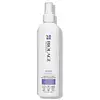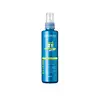What's inside
What's inside
 Key Ingredients
Key Ingredients

 Benefits
Benefits

 Concerns
Concerns

 Ingredients Side-by-side
Ingredients Side-by-side

Water
Skin ConditioningPropylene Glycol
HumectantPhenoxyethanol
PreservativePolyquaternium-37
Amodimethicone
Oleth-5
EmulsifyingPropylene Glycol Dicaprylate/Dicaprate
EmollientMethylparaben
PreservativePolyquaternium-11
Ethylhexyl Methoxycinnamate
UV AbsorberPanthenol
Skin ConditioningEthylparaben
PreservativePPG-1 Trideceth-6
Skin ConditioningParfum
MaskingCetrimonium Chloride
AntimicrobialTriethanolamine
BufferingTrideceth-12
EmulsifyingDisodium EDTA
Limonene
PerfumingTocopherol
AntioxidantHexyl Cinnamal
PerfumingCoumarin
PerfumingLinalool
PerfumingButylphenyl Methylpropional
PerfumingBenzyl Alcohol
PerfumingHydroxycitronellal
PerfumingAmyl Cinnamal
PerfumingAloe Barbadensis Extract
Skin ConditioningWater, Propylene Glycol, Phenoxyethanol, Polyquaternium-37, Amodimethicone, Oleth-5, Propylene Glycol Dicaprylate/Dicaprate, Methylparaben, Polyquaternium-11, Ethylhexyl Methoxycinnamate, Panthenol, Ethylparaben, PPG-1 Trideceth-6, Parfum, Cetrimonium Chloride, Triethanolamine, Trideceth-12, Disodium EDTA, Limonene, Tocopherol, Hexyl Cinnamal, Coumarin, Linalool, Butylphenyl Methylpropional, Benzyl Alcohol, Hydroxycitronellal, Amyl Cinnamal, Aloe Barbadensis Extract
Water
Skin ConditioningPropylene Glycol
HumectantCetearyl Alcohol
EmollientBehentrimonium Chloride
PreservativeCyclopentasiloxane
EmollientPanthenol
Skin ConditioningHydrolyzed Silk
HumectantChondrus Crispus
MaskingHydrolyzed Keratin
HumectantLinoleamidopropyl Pg-Dimonium Chloride Phosphate
Amodimethicone
Polysilicone-15
UV FilterSilicone Quaternium-22
Cetrimonium Chloride
AntimicrobialButylene Glycol
HumectantIsopropyl Alcohol
SolventPPG-3 Myristyl Ether
EmollientButyl Methoxydibenzoylmethane
UV AbsorberTocopheryl Acetate
AntioxidantXanthan Gum
EmulsifyingCitric Acid
BufferingTrideceth-12
EmulsifyingDisodium EDTA
Lecithin
EmollientCaprylyl Glycol
EmollientDiazolidinyl Urea
PreservativePhenoxyethanol
PreservativeIodopropynyl Butylcarbamate
PreservativePotassium Sorbate
PreservativeParfum
MaskingAmyl Cinnamal
PerfumingBenzyl Alcohol
PerfumingCitronellol
PerfumingCoumarin
PerfumingLimonene
PerfumingHydroxycitronellal
PerfumingLinalool
PerfumingBenzyl Benzoate
AntimicrobialAlpha-Isomethyl Ionone
PerfumingCinnamyl Alcohol
PerfumingWater, Propylene Glycol, Cetearyl Alcohol, Behentrimonium Chloride, Cyclopentasiloxane, Panthenol, Hydrolyzed Silk, Chondrus Crispus, Hydrolyzed Keratin, Linoleamidopropyl Pg-Dimonium Chloride Phosphate, Amodimethicone, Polysilicone-15, Silicone Quaternium-22, Cetrimonium Chloride, Butylene Glycol, Isopropyl Alcohol, PPG-3 Myristyl Ether, Butyl Methoxydibenzoylmethane, Tocopheryl Acetate, Xanthan Gum, Citric Acid, Trideceth-12, Disodium EDTA, Lecithin, Caprylyl Glycol, Diazolidinyl Urea, Phenoxyethanol, Iodopropynyl Butylcarbamate, Potassium Sorbate, Parfum, Amyl Cinnamal, Benzyl Alcohol, Citronellol, Coumarin, Limonene, Hydroxycitronellal, Linalool, Benzyl Benzoate, Alpha-Isomethyl Ionone, Cinnamyl Alcohol
Ingredients Explained
These ingredients are found in both products.
Ingredients higher up in an ingredient list are typically present in a larger amount.
This water-soluble silicone is used for its hydrating and softening properties. It is used to add a silky feel to skincare products and has great benefits for haircare.
In haircare, this ingredient:
- Adds shine
- Protects color
- Offers thermal protection
- Boosts hair strength
- Does not build up as easily
Amyl Cinnamal is a synthetically produced fragrance. Its scent is reminiscent of jasmine flowers.
Amyl Cinnamal is a known EU allergen. This means it is known to cause skin sensitivity and allergies.
Benzyl Alcohol is most commonly used as a preservative. It also has a subtle, sweet smell. Small amounts of Benzyl Alcohol is not irritating and safe to use in skincare products. Most Benzyl Alcohol is derived from fruits such as apricots.
Benzyl Alcohol has both antibacterial and antioxidant properties. These properties help lengthen the shelf life of products. Benzyl Alcohol is a solvent and helps dissolve other ingredients. It can also improve the texture and spreadability.
Alcohol comes in many different forms. Different types of alcohol will have different effects on skin. This ingredient is an astringent alcohol.
Using high concentrations of these alcohols are drying on the skin. They may strip away your skin's natural oils and even damage your skin barrier. Astringent alcohols may also irritate skin.
Other types of astringent alcohols include:
According to the National Rosacea Society based in the US, you should be mindful of products with these alcohols in the top half of ingredients.
Any type of sanitizing product will have high amounts of alcohol to help kill bacteria and viruses.
Learn more about Benzyl AlcoholThis ingredient is a preservative, antimicrobial, and emulsifier. It is often used in cosmetics for its ability to cleanse, condition, and reduce static.
Cetrimonium chloride is a quaternary ammonium salt, meaning it has a water-soluble structure.
Coumarins are a group of substances found naturally in plants. There are over 1300 types of coumarins identified. It has a natural vanilla scent.
Coumarin is an identified EU known allergy, meaning it may cause an allergic reaction when applied to the skin.
In many countries, coumarin is banned as a food additive. However, it can be found in soaps, tobacco products, and some alcohol drinks.
Plants use coumarins as a chemical defense. Some plants that have coumarins include lavender, tonka beans, and yellow clovers.
Learn more about CoumarinDisodium EDTA plays a role in making products more stable by aiding other preservatives.
It is a chelating agent, meaning it neutralizes metal ions that may be found in a product.
Disodium EDTA is a salt of edetic acid and is found to be safe in cosmetic ingredients.
Learn more about Disodium EDTAHydroxycitronellal is a fragrance created from citronellal. The smell of hydroxycitronellal is often described as "citrus-like" or "melon-like".
Hydroxycitronellal is a known EU allergen and may cause irritation when applied to the skin.
Limonene is a fragrance that adds scent and taste to a formulation.
It's found in the peel oil of citrus fruits and other plants such as lavender and eucalyptus. The scent of limonene is generally described as "sweet citrus".
Limonene acts as an antioxidant, meaning it helps neutralize free radicals.
When exposed to air, oxidized limonene may sensitize the skin. Because of this, limonene is often avoided by people with sensitive skin.
The term 'fragrance' is not regulated in many countries. In many cases, it is up to the brand to define this term. For instance, many brands choose to label themselves as "fragrance-free" because they are not using synthetic fragrances. However, their products may still contain ingredients such as essential oils that are considered a fragrance.
Learn more about LimoneneLinalool is a fragrance and helps add scent to products. It's derived from common plants such as cinnamon, mint, citrus, and lavender.
Like Limonene, this ingredient oxidizes when exposed to air. Oxidized linalool can cause allergies and skin sensitivity.
This ingredient has a scent that is floral, spicy tropical, and citrus-like.
Learn more about LinaloolPanthenol is a common ingredient that helps hydrate and soothe the skin. It is found naturally in our skin and hair.
There are two forms of panthenol: D and L.
D-panthenol is also known as dexpanthenol. Most cosmetics use dexpanthenol or a mixture of D and L-panthenol.
Panthenol is famous due to its ability to go deeper into the skin's layers. Using this ingredient has numerous pros (and no cons):
Like hyaluronic acid, panthenol is a humectant. Humectants are able to bind and hold large amounts of water to keep skin hydrated.
This ingredient works well for wound healing. It works by increasing tissue in the wound and helps close open wounds.
Once oxidized, panthenol converts to pantothenic acid. Panthothenic acid is found in all living cells.
This ingredient is also referred to as pro-vitamin B5.
Learn more about PanthenolParfum is a catch-all term for an ingredient or more that is used to give a scent to products.
Also called "fragrance", this ingredient can be a blend of hundreds of chemicals or plant oils. This means every product with "fragrance" or "parfum" in the ingredients list is a different mixture.
For instance, Habanolide is a proprietary trade name for a specific aroma chemical. When used as a fragrance ingredient in cosmetics, most aroma chemicals fall under the broad labeling category of “FRAGRANCE” or “PARFUM” according to EU and US regulations.
The term 'parfum' or 'fragrance' is not regulated in many countries. In many cases, it is up to the brand to define this term.
For instance, many brands choose to label themselves as "fragrance-free" because they are not using synthetic fragrances. However, their products may still contain ingredients such as essential oils that are considered a fragrance by INCI standards.
One example is Calendula flower extract. Calendula is an essential oil that still imparts a scent or 'fragrance'.
Depending on the blend, the ingredients in the mixture can cause allergies and sensitivities on the skin. Some ingredients that are known EU allergens include linalool and citronellol.
Parfum can also be used to mask or cover an unpleasant scent.
The bottom line is: not all fragrances/parfum/ingredients are created equally. If you are worried about fragrances, we recommend taking a closer look at an ingredient. And of course, we always recommend speaking with a professional.
Learn more about ParfumPhenoxyethanol is a preservative that has germicide, antimicrobial, and aromatic properties. Studies show that phenoxyethanol can prevent microbial growth. By itself, it has a scent that is similar to that of a rose.
It's often used in formulations along with Caprylyl Glycol to preserve the shelf life of products.
Propylene Glycol is an odorless, colorless liquid. As a humectant, it helps skin retain moisture. It also aids in delivering active ingredients.
Another role of this ingredient is preventing a product from melting or freezing. Propylene glycol also adds antimicrobrial properties to a product, elongating product lifespan.
This ingredient is considered an organic alcohol and commonly added into both cosmetics and foods.
Those with sensitive skin or conditions may develop a rash when using this ingredient.
Learn more about Propylene GlycolWe don't have a description for Trideceth-12 yet.
Water. It's the most common cosmetic ingredient of all. You'll usually see it at the top of ingredient lists, meaning that it makes up the largest part of the product.
So why is it so popular? Water most often acts as a solvent - this means that it helps dissolve other ingredients into the formulation.
You'll also recognize water as that liquid we all need to stay alive. If you see this, drink a glass of water. Stay hydrated!
Learn more about Water